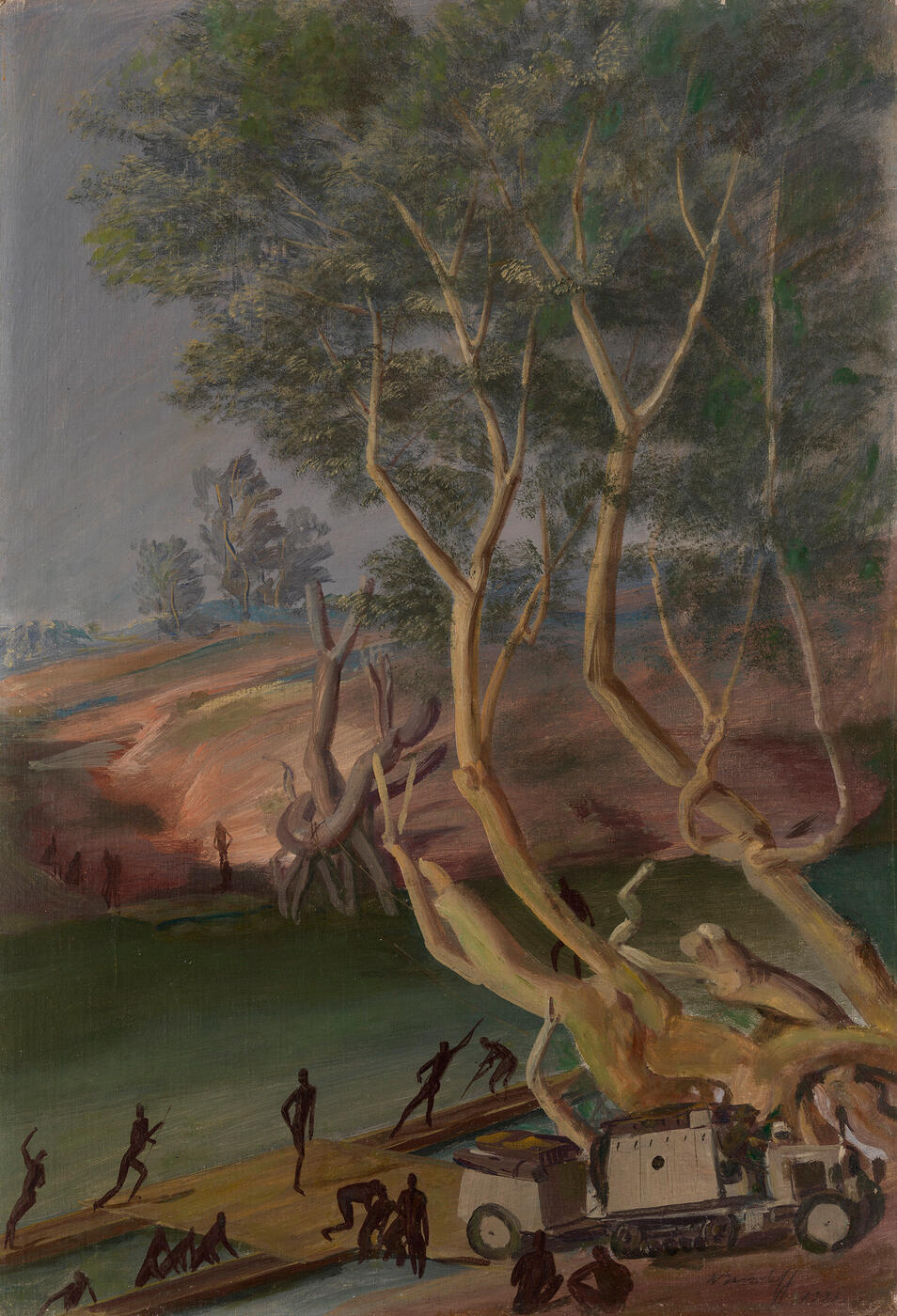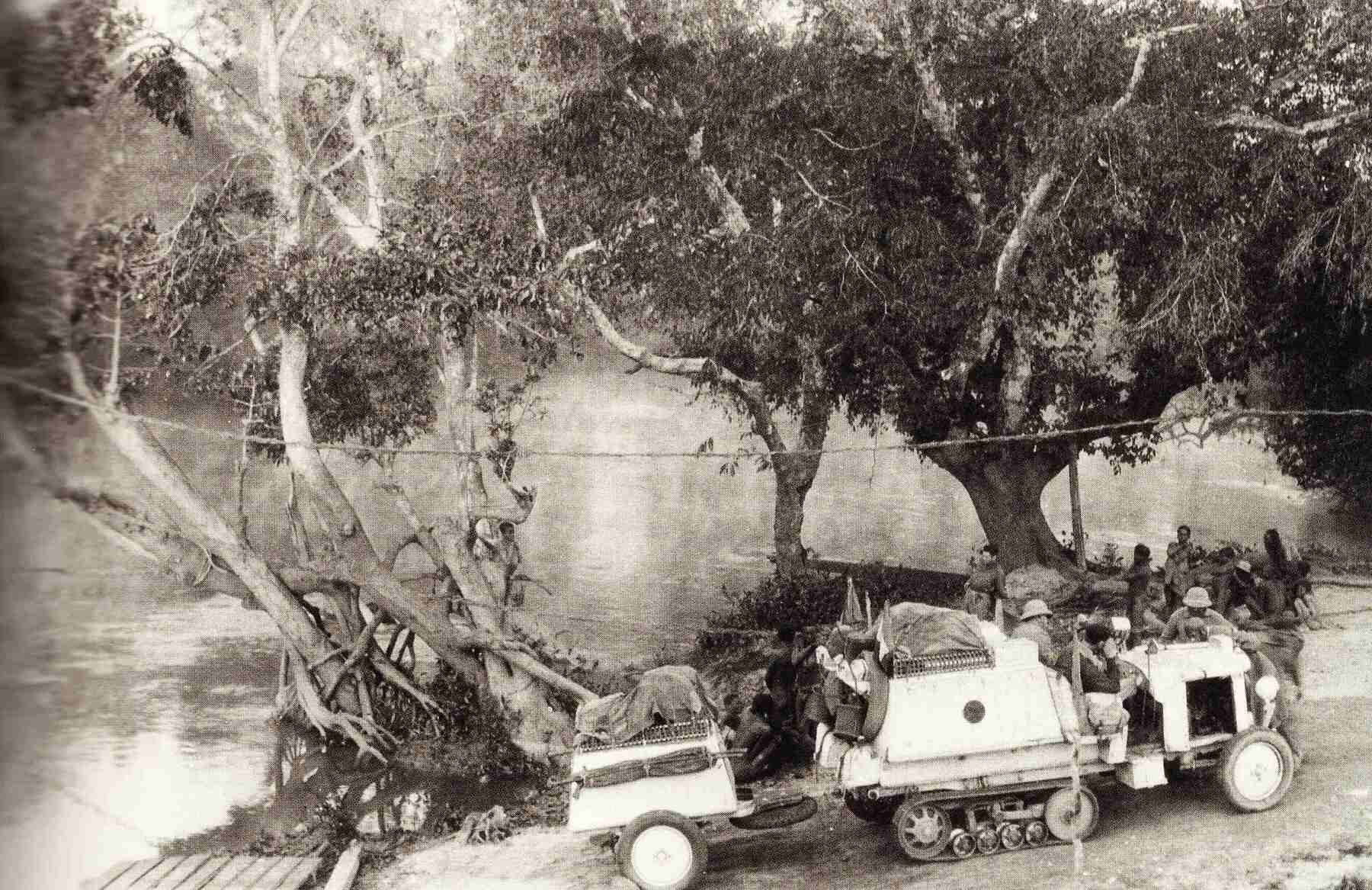MacDougall's Russian Art Auctions 8-9 June 2011
8 June 2011

* 38. YAKOVLEV, ALEXANDER (1887-1938)
Crossing the Kemo, in Oubangui-Chari, signed and dated 1925.
Oil on canvas, 75.5 by 52.5 cm.
180,000-220,000 GBP
Provenance: Private collection, Europe.
Authenticity of the work has been confirmed by the experts Yu. Rybakova and E. Yakovleva.
Exhibited: A. Iacovleff, Stanleyville, Belgian Congo, 1925.
Possibly A. Iacovleff, Galerie J. Charpentier, Paris, 7-23 May 1926.
Literature: Exhibition catalogue, A. Iacovleff, Galerie J. Charpentier, Paris, 7-23 May 1926, p. 5, possibly listed as No. 49, L'Oubangui.
L. Thornton, Les Africanistes, peintres voyageurs 1860-1960, Paris, A.C.R. Edition, 1990, p. 117, illustrated.
C. Haardt de la Baume, Alexandre Iacovleff, l'artiste voyageur, Flammarion, Paris, 2000, p. 26, illustrated as La traversée de la Kemo.
Related literature: For a photograph of the crossing of the Kemo, see Fabien Sabatés, La Croisière Noire Citroen, Paris, Eric Baschet Editions, 1980.
Alexander Yakovlev painted Crossing the Kemo, in Oubangui-Chari in early 1925 in Central Africa, in Oubangui-Chari (at that time a French colony), during a Trans-African expedition organised by the French automobile manufacturer Citroën.
The expedition lasted from October 1924 to June 1925 and turned out to be of great value in testing new half-track vehicles, assembling unique ethnographic, zoological and botanical collections and creating a mass of documentary and artistic material. In the course of the expedition film footage was shot, thousands of photographs taken and the artist Alexander Yakovlev produced hundreds of first-class drawings and paintings: portraits of the indigenous population and expedition members, landscapes and narrative works recounting the lives of African tribes and peoples. The artist worked in the most varied and sometimes difficult conditions, striving to record artistically, and with extreme accuracy and authenticity, every interesting event, occurrence, person and animal.
When setting off for Africa, Yakovlev, by his own admission, wanted "not only to collect material but also to reach a new phase in my creative development". Judging by the works he produced, his wish was fulfilled. Those exhibited at the first three travelling exhibitions, organised in the course of the expedition, were admired not only by fellow-members of the expedition but also by the local inhabitants. After his return, Yakovlev showed his work at a large-scale solo exhibition in "the most prominent art salon in Paris", the Galerie Jean Charpentier. After her visit, the artist Anna Ostroumova-Lebedeva admired Yakovlev's "tremendous success" at that time -the greatest success, she said, of all the Parisian artists. She noted that during the exhibition's run there was no periodical or newspaper that did not feature articles about and photographs of Yakovlev's work: "The writers of the articles considered him highly gifted." Konstantin Somov also praised the exhibition, adding that Yakovlev's works were "in great demand, and they say he has sold almost all of them already, for several hundred thousand francs". In a letter to his sister, Somov reported that Yakovlev was awarded the Légion d'Honneur and that the president visited the exhibition. This was indeed genuine recognition of the talent and hard work of this Russian artist, who had created his works during overnight bivouacs, after the draining heat and arduous travel of the days.
The exhibition comprised 228 works - 88 paintings and 140 drawings, in which the artist recorded the landscape and the indigenous people of the Sahara, Sudan, Niger, Tchad, French Equatorial Africa, Belgian Congo, Mozambique and Madagascar. Among the works exhibited was Crossing the Kemo, in Oubangui-Chari. Comparing it with photographs taken in Oubangui-Chari on the border with the Belgian Congo, it is evident that the artist has created in this painting a composite image of the crossing of one of the many river boundaries which the expedition members had to negotiate.
In planning his composition the artist brought together a narrative element, concentrated mainly in the lower part of the picture, and an African landscape, featuring a narrow river (or small tributary) and gently-sloping banks on which exotic trees are growing- macarangas with their typically fantastical supporting roots, long, contorted trunks and branching crowns all intertwined. Tree-trunks on the two sides of the river are linked by stout cables, enabling a pontoon ferry to cross. The high viewpoint taken for this depiction of the near bank and the crossing allowed the artist to show the extraordinary body movements of the dark-skinned ferrymen, skilfully manipulating poles and ropes. It is as if he were inviting the viewer to take an overview of the process of mooring the wooden raft of three-inch planks placed on top of two long, parallel pirogues; to watch how the Africans haul on the ropes and how, standing up to their knees in water, they push the heavy pontoon structure towards the bank and, bracing themselves with their staffs against the river bed, enable the ferry to make fast to the bank. Thanks to this operation the ferry has successfully moored and the vehicle with its trailer has disembarked on to the bank. It appears that this crossing, unlike some others, has not presented too many problems. Perhaps this is why the artist has made the landscape the dominant element of the picture, occupying the greater part of it.
The impeccable composition appears easy and unstudied as, incidentally, do the compositions of Yakovlev's other African works. The graphic nature of this painting, typical of this artist's work of the mid-1920s, is seen here in the precision of the outlines, the boldness of the drawing and the clearly-defined modelling of the tree-trunks. The restrained colour range of the picture is also in harmony with the composition. The landscape depicted here draws associations with Neo-Classicism: Yakovlev had already been praised as an outstanding Neo-Classicist back in the 1910s, early in his painting career, when he had just graduated from the Higher Art School at the Imperial Academy of Fine Arts. He was, according to the St Petersburg critics, the "great hope of young Russian art".
Dr Elena Yakovleva, art historian

Notes on symbols:
* Indicates 5% Import Duty Charge applies.
Ω Indicates 20% Import Duty Charge applies.
§ Indicates Artist's Resale Right applies.
† Indicates Standard VAT scheme applies, and the rate of 20% VAT will be charged on both hammer price and premium.